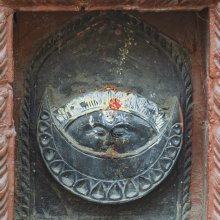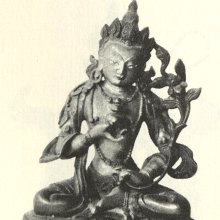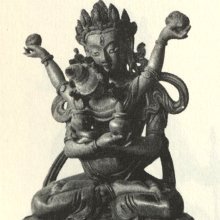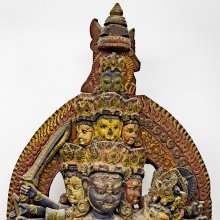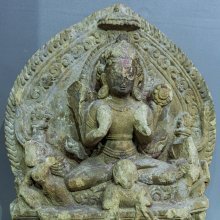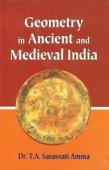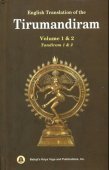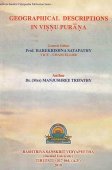Candra, Cāndra, Candrā, Camdra: 56 definitions
Introduction:
Candra means something in Buddhism, Pali, Hinduism, Sanskrit, Jainism, Prakrit, the history of ancient India, Marathi, biology. If you want to know the exact meaning, history, etymology or English translation of this term then check out the descriptions on this page. Add your comment or reference to a book if you want to contribute to this summary article.
Alternative spellings of this word include Chandra.
Images (photo gallery)
(+10 more images available)
In Hinduism
Natyashastra (theatrics and dramaturgy)
Source: archive.org: The mirror of gesture (abhinaya-darpana)One of the Nava-graha (Hands that indicate the Nine Planets).—Candra: left hand–Solapadma, right hand–Patāka.
Source: Shodhganga: The significance of the mūla-beras (natya)Candra (चन्द्र) refers to the moon, which can de depicted using hand gestures (hasta or mudrā).—The right hand assumes alapadma and the left hand holds patāka-hasta to depict Candra in dance.
There are two other depictions of the moon (candra):
- bāla-candra (rising moon),
- pūrṇa-candra (full moon).
To show bāla-candra (rising moon), the left hand is raised with tripatāka or kartarī-hasta while the right hand assumes ardhcandra-hasta and held just over the left shoulder. The look is natural and the posture is sama-sthānaka. To depict the pūrṇacandra (full moon), the left hand assumes kartarīmukha or tripatāka-hasta which is stretched upward while the right hand assumes sūcī-hasta androtates above; the look is directed upwards.

Natyashastra (नाट्यशास्त्र, nāṭyaśāstra) refers to both the ancient Indian tradition (shastra) of performing arts, (natya—theatrics, drama, dance, music), as well as the name of a Sanskrit work dealing with these subjects. It also teaches the rules for composing Dramatic plays (nataka), construction and performance of Theater, and Poetic works (kavya).
Ayurveda (science of life)
Kalpa (Formulas, Drug prescriptions and other Medicinal preparations)
Source: Ancient Science of Life: Yogaśataka of Pandita VararuciCandrā (चन्द्रा) is the name of an unidentified medicinal plant mentioned in the 10th century Yogaśataka written by Pandita Vararuci.—The Yogaśataka of Pandita Vararuci is an example of this category. This book attracts reader by its very easy language and formulations which can be easily prepared and have small number of herbs (viz., Candrā). It describes only those formulations which are the most common and can be used in majority conditions of diseases.
Unclassified Ayurveda definitions
Source: Wisdom Library: Āyurveda and botanyCandra (चन्द्र) is another name for Kampillaka (Mallotus philippensis) according to the Bhāvaprakāśa, which is a 16th century medicinal thesaurus authored by Bhāvamiśra. The term is used throughout Ayurvedic literature. It can also be spelled as Kampilla (कम्पिल्ल).

Āyurveda (आयुर्वेद, ayurveda) is a branch of Indian science dealing with medicine, herbalism, taxology, anatomy, surgery, alchemy and related topics. Traditional practice of Āyurveda in ancient India dates back to at least the first millenium BC. Literature is commonly written in Sanskrit using various poetic metres.
Jyotisha (astronomy and astrology)
Source: Wisdom Library: JyotiṣaCandra (चन्द्र, “shining”) refers to the moon, which is also known as soma or śiśira, amonst others. The corresponding day of the week is sunday (somavāra). The term is used throughout Jyotiṣa literature.
Source: Wisdom Library: Brihat Samhita by VarahamihiraCāndra (चान्द्र) refers to the “lunar calendar”, according to the Bṛhatsaṃhitā (chapter 2), an encyclopedic Sanskrit work written by Varāhamihira mainly focusing on the science of ancient Indian astronomy astronomy (Jyotiṣa).—Accordingly, “We shall now proceed to give a brief description of (the qualifications of) a jyotiṣaka. [...] He must have a clear knowledge of the causes of Solar, Savana, Siderial and Lunar [i.e., cāndra] months as well as of intercalary lunations and intercalary days. He must have a knowledge of the beginning and end of Śaṣṭyābda (a cycle of 60 years) [Ṣaṣṭyabda?], a Yuga (5 years), Varṣa (a year), Māsa (a month), Thina (a day) and Horā (an hour) and of their lords”.

Jyotisha (ज्योतिष, jyotiṣa or jyotish) refers to ‘astronomy’ or “Vedic astrology” and represents the fifth of the six Vedangas (additional sciences to be studied along with the Vedas). Jyotisha concerns itself with the study and prediction of the movements of celestial bodies, in order to calculate the auspicious time for rituals and ceremonies.
Purana and Itihasa (epic history)
Source: Wisdom Library: Varāha-purāṇa1) Candra (चन्द्र).—Another name for Jaladhāra, which is one of the seven major mountains in Śākadvīpa, according to the Varāhapurāṇa chapter 86. Śākadvīpa is one of the seven islands (dvīpa), ruled over by Medhātithi, one of the ten sons of Priyavrata.
2) Candrā (चन्द्रा) is another name for Hrādinī, one of the seven major rivers in Kuśadvīpa, according to the Varāhapurāṇa chapter 87. Kuśadvīpa is one of the seven islands (dvīpa), ruled over by Vapuṣmān, one of the ten sons of Priyavrata.
Priyavrata is the son of Svāyambhuva Manu, who was created by Brahmā, who was in turn created by Nārāyaṇa, the unknowable all-pervasive primordial being.
The Varāhapurāṇa is categorised as a Mahāpurāṇa, and was originally composed of 24,000 metrical verses, possibly originating from before the 10th century. It is composed of two parts and Sūta is the main narrator.
Source: Wisdom Library: Bhagavata PuranaCandra (चन्द्र):—Son of Viśvagandhi (son of Pṛthu). He had a son named Yuvanāśva. (see Bhāgavata Purāṇa 9.6.20)
Source: archive.org: Puranic Encyclopedia1) Candra (चन्द्र).—A prominent asura, also called Candravarman. It was this asura, as beautiful as Candra (the moon) who was born as the king of Kāmboja under the name Candravarman (Mahābhārata Ādi Parva, Chapter 67, Verse 31). (See full article at Story of Candra from the Puranic encyclopaedia by Vettam Mani)
2) Candra (चन्द्र).—A king born in the Solar dynasty and the son of Viśvarandhi and father of Yuvanāśva. See Vaṃśāvalī)
3) Candra (चन्द्र).—The Purāṇas declare that Candra was one of the invaluable things got at the churning of Kṣīrābdhi (ocean of milk) Candra, Mahālakṣmī, Surā, Uccaiḥśravas, Kaustubha, Pārijāta, Kāmadhenu, Dhanvantari, Amṛtam and Kālakūṭa were the things thus got from the Ocean of Milk. (Mahābhārata Ādi Parva, Chapter 18 and Viṣṇu Purāṇa, Part 1, Chapter 9). Also, the evil devatā called Jyeṣṭhā, Airāvata, the gem named Cintāmaṇi and fair damsels like Tārā and Rumā were got from the Kṣīrābdhi, (Kampa Rāmāyaṇa, Yuddhakāṇḍa). For general information about Candra, see Grahas).
4) Candra (चन्द्र).—(CANDRA DEVA). Birth. The child born to Atri by Anasuyā. (See Purūravas). In Skandha 4 of the Devībhāgavata it is stated that it was Brahman who was born as Candra. (See Atri).
5) Candrā (चन्द्रा).—An important river in ancient India. (Bhīṣma Parva, Chapter 9, Verse 29).
Source: Cologne Digital Sanskrit Dictionaries: The Purana Index1a) Candra (चन्द्र).—(personified) pointed out, in the Amṛtamathana, to Hari, Rāhu drinking nectar in the guise of a deva. Hence Rāhu is said to chase the moon in parvas. Fought with Rāhu in a Devāsura war.*
- * Bhāgavata-purāṇa VIII. 9. 24-26; 10. 31.
1b) The son of Viśvasandhi and father of Yuvanāśva.*
- * Bhāgavata-purāṇa IX. 6. 20.
1c) A son of Kṛṣṇa and Satyā.*
- * Bhāgavata-purāṇa X. 61. 13.
1d) A son of Bali.*
- * Matsya-purāṇa 6. 11.
1e) One of Danu's sons.*
- * Vāyu-purāṇa 68. 8.
1f) The son of Nara and father of Kevala.*
- * Viṣṇu-purāṇa IV. 1. 41-2.
1g) The son of Hemacandra, and father of Dhūmrākṣa.*
- * Viṣṇu-purāṇa IV. 1. 51-2.
1h) The moon who completes in two fortnights the circuit which the sun makes in a year. He is the life of all living beings and occupies each of the twenty-eight constellations for thirty muhūrtas (a day).1 Lord of plants, yajñas, vratas and tapas; not going near Rohini, a bad omen;2 the whitish dark spot in it appears like a śara;3 its maṇḍalam made of clouds and waters as of Sūrya; here is the sthāna of all deities, planets, etc., the size of the moon is twice that of the sun; is reckoned as Vasu in the Vaivasvata epoch;4 grows through the effulgence of the sun and is known as Idvatsara; has 15 kalas and not 16.5
- 1) Bhāgavata-purāṇa II. 10. 30; V. 22. 8-10.
- 2) Matsya-purāṇa 8. 2; 163. 41; 246. 57.
- 3) Vāyu-purāṇa 47. 77.
- 4) Ib. 53. 55-62, 80.
- 5) Ib. 56. 30-31.
1i) A mountain one of the seven mountains of Plakṣadvīpa touching the sea and medicinal plants gathered by the Aśvins for nectar.*
- * Brahmāṇḍa-purāṇa II. 18. 76; 19. 8; Vāyu-purāṇa 49. 7; Viṣṇu-purāṇa II. 4. 7.
1j) A group of nāḍis of sun (fire) with enough light.*
- * Brahmāṇḍa-purāṇa II. 24. 29.
2a) Candrā (चन्द्रा).—A river in Śālmalidvīpa.*
- * Brahmāṇḍa-purāṇa II. 19. 46; Vāyu-purāṇa 49. 42; Viṣṇu-purāṇa II. 4. 28.
2b) A daughter of Vṛṣaparvan.*
- * Matsya-purāṇa 6. 22.
Candra (चन्द्र) is a name mentioned in the Mahābhārata (cf. I.61.28) and represents one of the many proper names used for people and places. Note: The Mahābhārata (mentioning Candra) is a Sanskrit epic poem consisting of 100,000 ślokas (metrical verses) and is over 2000 years old.

The Purana (पुराण, purāṇas) refers to Sanskrit literature preserving ancient India’s vast cultural history, including historical legends, religious ceremonies, various arts and sciences. The eighteen mahapuranas total over 400,000 shlokas (metrical couplets) and date to at least several centuries BCE.
Pancaratra (worship of Nārāyaṇa)
Source: Wisdom Library: PāñcarātraCandra (चन्द्र) refers to an aspect of nṛsiṃha (‘man-lion’), according to the Vihagendra-saṃhitā 4.17, which mentions seventy-four forms (inlcuding twenty forms of vyūha). He is also known as Candranṛsiṃha or Candranarasiṃha. Nṛsiṃha is a Tantric deity and refers to the furious (ugra) incarnation of Viṣṇu.
The 15th-century Vihagendra-saṃhīta is a canonical text of the Pāñcarātra corpus and, in twenty-four chapters, deals primarely with meditation on mantras and sacrificial oblations.

Pancaratra (पाञ्चरात्र, pāñcarātra) represents a tradition of Hinduism where Narayana is revered and worshipped. Closeley related to Vaishnavism, the Pancaratra literature includes various Agamas and tantras incorporating many Vaishnava philosophies.
Vastushastra (architecture)
Source: Wisdom Library: Vāstu-śāstraCandra (चन्द्र, “monday”) corresponds with the moon and refers to the second of seven vāra (days), according to the Mānasāra. It is also known by the name Soma or Śaśi. Vāra is the fifth of the āyādiṣaḍvarga, or “six principles” that constitute the “horoscope” of an architectural or iconographic object. Their application is intended to “verify” the measurements of the architectural and iconographic object against the dictates of astrology that lay out the conditions of auspiciousness.
The particular day, or vāra (e.g., candra) of all architectural and iconographic objects (settlement, building, image) must be calculated and ascertained. This process is based on the principle of the remainder. An arithmetical formula to be used in each case is stipulated, which engages one of the basic dimensions of the object (breadth, length, or perimeter/circumference). Among these vāras, Guru (Thursday), Śukra (Friday), Budha (Wednesday) and Śaśi or Candra (Monday), are considered auspicious and therefore, to be preferred. The text states, however, that the inauspiciousness of the other three days are nullified if there occurs a śubhayoga, “auspicious conjunction (of planets)” on those days.
Source: Shodhganga: Elements of Art and Architecture in the Trtiyakhanda of the Visnudharmottarapurana (vastu)Candra (चन्द्र) refers to one of the hundred types of Temples (in ancient Indian architecture), according to the Viṣṇudharmottarapurāṇa, an ancient Sanskrit text which (being encyclopedic in nature) deals with a variety of cultural topics such as arts, architecture, music, grammar and astronomy.—It is quite difficult to say about a definite number of varieties of Hindu temples but in the Viṣṇudharmottarapurāṇa hundred varieties of temples have been enumerated. For example, Candra. These temples are classified according to the particular shape, amount of storeys and other common elements, such as the number of pavilions, doors and roofs.

Vastushastra (वास्तुशास्त्र, vāstuśāstra) refers to the ancient Indian science (shastra) of architecture (vastu), dealing with topics such architecture, sculpture, town-building, fort building and various other constructions. Vastu also deals with the philosophy of the architectural relation with the cosmic universe.
Vyakarana (Sanskrit grammar)
Source: Wikisource: A dictionary of Sanskrit grammarCandra (चन्द्र).—A famous Buddhist Sanskrit grammarian whose grammar existing in the Tibetan script, is now available in the Devanagar script. The work consists of six chapters or Adhyayas in which no technical terms or sanjnas like टि, घु (ṭi, ghu) are found. There is no section on Vedic Grammar and accents. The work is based on Panini's grammar and is believed to have been written by Candra or Candragomin in the 5th centnry A. D. Bhartrhari in his Vakyapadiya refers to him; cf. स नीतो बहुशाखत्वं चन्द्राचार्यादिभिः पुनः (sa nīto bahuśākhatvaṃ candrācāryādibhiḥ punaḥ) Vakyapadiya II. 489. A summary of the work is found in the Agnipurana, ch. 248-258.
--- OR ---
Cāndra (चान्द्र).—Name of a treatise on grammar written by Candra, who is believed to have been the same as Candragomin. The Grammar is based upon that of Panini, but it does not treat Vedic forms and accents. See the word चन्द्र (candra) above. For details see pp. 375-376 Patanjali Mahabhasya. Vol. VII, D.E. Society's Edition.

Vyakarana (व्याकरण, vyākaraṇa) refers to Sanskrit grammar and represents one of the six additional sciences (vedanga) to be studied along with the Vedas. Vyakarana concerns itself with the rules of Sanskrit grammar and linguistic analysis in order to establish the correct context of words and sentences.
Chandas (prosody, study of Sanskrit metres)
Source: Shodhganga: a concise history of Sanskrit Chanda literatureCandra (चन्द्र) refers to one of the 130 varṇavṛttas (syllabo-quantitative verse) dealt with in the second chapter of the Vṛttamuktāvalī, ascribed to Durgādatta (19th century), author of eight Sanskrit work and patronised by Hindupati: an ancient king of the Bundela tribe (presently Bundelkhand of Uttar Pradesh). A Varṇavṛtta (e.g., candra) refers to a type of classical Sanskrit metre depending on syllable count where the light-heavy patterns are fixed.

Chandas (छन्दस्) refers to Sanskrit prosody and represents one of the six Vedangas (auxiliary disciplines belonging to the study of the Vedas). The science of prosody (chandas-shastra) focusses on the study of the poetic meters such as the commonly known twenty-six metres mentioned by Pingalas.
Shilpashastra (iconography)
Source: Shodhganga: The significance of the mūla-beras (śilpa)1) Candra (चन्द्र, “moon”) refers to one of the Navagraha (“nine planetary divinities”), as defined according to texts dealing with śilpa (arts and crafs), known as śilpaśāstras.—Few planets are discussed with respect to the hastas in Bharatanatyam and iconography. In the images, Candra is found with two hands holding a flower each in kaṭaka-hasta.
2a) Candra (चन्द्र) is the name of a deity depicted in the Thillai Nataraja Temple in Cidambaram (Chidambaram) which is one of the Pañcasabhā or “five halls where Śiva is said to have danced”.— Candra is found in samapāda-sthānaka with two hands. The right and the left hands each hold a water lilly in kaṭaka-hasta.
b) Candra is also depicted at the Nellaiappar Temple at Tirunelveli, representing a sacred place for the worship of Śiva.—Candra is standing in posture with the two upper hands in kaṭaka-hasta holding the lotus and the other hands in abhaya and varada.
c) Candra is also depicted in the Meenakshi Temple in Madurai (or Madura), which represents a sacred place for the worship of The Goddess (Devī).—Candra is represented with four hands where the upper hands hold abhaya and varada in the right and left respectively.

Shilpashastra (शिल्पशास्त्र, śilpaśāstra) represents the ancient Indian science (shastra) of creative arts (shilpa) such as sculpture, iconography and painting. Closely related to Vastushastra (architecture), they often share the same literature.
Kavya (poetry)
Source: archive.org: Naisadhacarita of SriharsaCāndra (चान्द्र) refers to (1) “pertaining to the moon”, (2) “belonging to camphor” and is mentioned in the Naiṣadha-carita 16.100. Candra is frequently used in Naiṣadh ain the sense of “camphor”, e.g., in 1.51; 6.36; 11.5; 18.5; 22.88. Cf. [a verse] quoted in Kṛtyakalpataru (Vratakāṇḍa), p. 270 (G.O.S.). Commentary explains Indu as Karpura.

Kavya (काव्य, kavya) refers to Sanskrit poetry, a popular ancient Indian tradition of literature. There have been many Sanskrit poets over the ages, hailing from ancient India and beyond. This topic includes mahakavya, or ‘epic poetry’ and natya, or ‘dramatic poetry’.
Vaishnavism (Vaishava dharma)
Source: Pure Bhakti: Bhagavad-gita (4th edition)Candra (चन्द्र) refers to “moon-god”. (cf. Glossary page from Śrīmad-Bhagavad-Gītā).
Source: Brill: Śaivism and the Tantric Traditions (vaishnavism)Candra (चन्द्र) refers to the “moon”, according to the Vedānta Deśika’s Yatirājasaptati.—When we come to the poem’s understanding of the divinity of Rāmānuja we find a wide spectrum of meanings. [...] Verse 28 is particularly eloquent in describing and encapsulating all his nurturing and protecting qualities, which are compared to those present everywhere in nature itself—as the mountain from which originate all the streams of knowledge, the tree under which the weary traveler wandering in saṃsāra takes rest, the rising sun that keeps the illusionary darkness of those with distorted views at bay and the full moon (pūrṇa-candra) that brings to high tide the ocean of the Vedas.

Vaishnava (वैष्णव, vaiṣṇava) or vaishnavism (vaiṣṇavism) represents a tradition of Hinduism worshipping Vishnu as the supreme Lord. Similar to the Shaktism and Shaivism traditions, Vaishnavism also developed as an individual movement, famous for its exposition of the dashavatara (‘ten avatars of Vishnu’).
Shaktism (Shakta philosophy)
Source: Google Books: Manthanabhairavatantram1) Candra (चन्द्र) is the name of a sacred place classified as a Pīṭha, according to the Manthānabhairavatantra, a vast sprawling work that belongs to a corpus of Tantric texts concerned with the worship of the goddess Kubjikā.—The eight seats are the main group of eight groups [i.e., Candra] of eight types of sacred sites. The figure sixty-four is a common ideal number as it is often configured into eight groups of eight.
2) Candra (चन्द्र) refers to one of the twenty-one spheres of the rūpa state, according to Tantric texts such as the Kubjikāmata-tantra, the earliest popular and most authoritative Tantra of the Kubjikā cult.—Chapter nineteen of the Kubjikāmatatantra begins with an exposition of the state called Form (rūpa). This is manifest in twenty-one spheres (cakra) [i.e., Candra] of ‘millions’ (koṭi) of energies arranged along the axis of the head starting with the throat, up through the eyebrows and beyond. [...]

Shakta (शाक्त, śākta) or Shaktism (śāktism) represents a tradition of Hinduism where the Goddess (Devi) is revered and worshipped. Shakta literature includes a range of scriptures, including various Agamas and Tantras, although its roots may be traced back to the Vedas.
Ganitashastra (Mathematics and Algebra)
Source: archive.org: Hindu MathematicsCandra (चन्द्र) represents the number 1 (one) in the “word-numeral system” (bhūtasaṃkhyā), which was used in Sanskrit texts dealing with astronomy, mathematics, metrics, as well as in the dates of inscriptions and manuscripts in ancient Indian literature.—A system of expressing numbers by means of words arranged as in the place-value notation was developed and perfected in India in the early centuries of the Christian era. In this system the numerals [e.g., 1—candra] are expressed by names of things, beings or concepts, which, naturally or in accordance with the teaching of the Śāstras, connote numbers.

Ganitashastra (शिल्पशास्त्र, gaṇitaśāstra) refers to the ancient Indian science of mathematics, algebra, number theory, arithmetic, etc. Closely allied with astronomy, both were commonly taught and studied in universities, even since the 1st millennium BCE. Ganita-shastra also includes ritualistic math-books such as the Shulba-sutras.
General definition (in Hinduism)
Source: Wisdom Library: Hinduism1) Candra (चन्द्र) is a Sanskrit term meaning “the moon” or “shining”.
2) Cāndra (चान्द्र) can mean “monday”, “lunar”, “light half of a month” or “lunar month”.
Source: Apam Napat: Indian MythologyChandra is said to have emerged from the sea of milk, when it was churned by both the Asuras and Devas. Due to his brilliant form he was given the status of a planet, one of the Navagrahas. He is considered one of the Devas. He is also referred to in the texts as Soma.
The Maarkandeya Purana makes Chandra to be the son of the sage Atri and his wife Anasuya, by the divine grace of Brahma. According to this story, the power of Brahma entered Atri and was born as Chandra to his wife.
Source: Red Zambala: The Navagrahas — Planetary DeitiesCandra is said to be the son of Prabhākra (the Sun). He is also identified with the Vedic Soma. Soma = Amṛta the nectar of immortality which alludes to the nourishing, nurturing and invigorating influence of the Moon on all life forms. He is described as young, beautiful, fair; two- armed and having in his hands a club and a displaying the Varadā mudra, or holding 2 white lotuses.
In Buddhism
Mahayana (major branch of Buddhism)
Source: Wisdom Library: Maha Prajnaparamita SastraCandra (चन्द्र) and Sūrya were two sons of the king of Mithilā according to the Mahāvastu mentioned at a footnote at the 2nd century Mahāprajñāpāramitāśāstra (chapter XXVIII). Accordingly, “Sūrya and Candra were sons of a Brāhman-king of Mithilā (called Jen t’ien, Maṇusyadeva (?) in T 190). The throne becoming vacant, Sūrya gave the kingdom to his brother and became a hermit. But having made the vow not to take anything, even a drop of water that was not given to him, one day he inadvertently violated his vow by drinking the water in the vase of an ascetic. Considering himself to be a thief, he demanded first from his disciples, then from his brother, the punishment he thought he deserved. Candra, in order to please him and to rid him of his scruples made him live for six days in an aśoka forest where he was given the most delicate of food. At the end of six days, he proclaimed a general amnesty that freed Sūrya. Rāhula was at that time Candra, the Buddha was Sūrya”.
Source: academia.edu: A Study and Translation of the GaganagañjaparipṛcchāCandra (चन्द्र) refers to the “moon”, according to the Gaganagañjaparipṛcchā: the eighth chapter of the Mahāsaṃnipāta (a collection of Mahāyāna Buddhist Sūtras).—Accordingly, “[...] The Bodhisattva Gaganagañja then sustained the jewel-canopy of ten thousand yojanas high over the Lord’s lion throne in the sky, joined the palms of his hands, saluted, and praised the Lord with these suitable verses: ‘[...] (13) The parts of the personality, realms and fields of perception (skandhadhātu-āyatana) are as an illusion (māyā-upama); the three worlds are as the reflection of the moon in the water (udaka-candra-upama) without change (acyuta); all living beings are non-existence (abhāva) as a dream (svapnopama). Having realized the fact that all things are like a dream by the knowledge, you teach this dharma. [...]”.

Mahayana (महायान, mahāyāna) is a major branch of Buddhism focusing on the path of a Bodhisattva (spiritual aspirants/ enlightened beings). Extant literature is vast and primarely composed in the Sanskrit language. There are many sūtras of which some of the earliest are the various Prajñāpāramitā sūtras.
Tibetan Buddhism (Vajrayana or tantric Buddhism)
Source: Wisdom Library: Tibetan BuddhismCandrā (चन्द्रा) is the name of Vidyārājñī (i.e., “wisdom queen”) mentioned as attending the teachings in the 6th century Mañjuśrīmūlakalpa: one of the largest Kriyā Tantras devoted to Mañjuśrī (the Bodhisattva of wisdom) representing an encyclopedia of knowledge primarily concerned with ritualistic elements in Buddhism. The teachings in this text originate from Mañjuśrī and were taught to and by Buddha Śākyamuni in the presence of a large audience (including Candrā).
Source: archive.org: The Indian Buddhist Iconography1) Candrā (चन्द्रा) is another name for Cundā: one of the various emanations of Vairocana, as mentioned in the 5th-century Sādhanamālā (a collection of sādhana texts that contain detailed instructions for rituals).—Her Colour is white;her Symbol is the book on lotus; she has one face, and two, four, sixteen, eighteen or twenty-six arms.—According to the Niṣpannayogāvalī under the mañjuvajra-maṇḍala, Cundā is affiliated to the Dhyāni Buddha Vairocana, and thus Cundā is the spiritual daughter of Vairocana, and is required to be classed under the emanations of this very Dhyāni Buddha.
2) Candrā (चन्द्रा) or Candradeva refers to the Moon-God and represents one of the nine planets (Navagraha), commonly depicted in Buddhist Iconography, and mentioned in the 11th-century Niṣpannayogāvalī of Mahāpaṇḍita Abhayākara.—His colour is white; his Symbols are the discs of the moon; his Vehicle is the swan; he has two arms.
Candra is described in the Niṣpannayogāvalī (dharmadhātuvāgīśvara-maṇḍala) as follows:—
Source: OSU Press: Cakrasamvara Samadhi“Candra rides on a Swan, is white in colour and holds in his right and left hands the discs of the Moon on lotuses”.
[As Candradeva this planet is popular in the Chinese collection].
Candra (चन्द्र) or “the moon”, is the name of a deity or entity to which is given homage to [i.e., oṃ aṃ candrāya namaḥ], according to the Guru Mandala Worship (maṇḍalārcana) ritual often performed in combination with the Cakrasaṃvara Samādhi, which refers to the primary pūjā and sādhanā practice of Newah Mahāyāna-Vajrayāna Buddhists in Nepal.

Tibetan Buddhism includes schools such as Nyingma, Kadampa, Kagyu and Gelug. Their primary canon of literature is divided in two broad categories: The Kangyur, which consists of Buddha’s words, and the Tengyur, which includes commentaries from various sources. Esotericism and tantra techniques (vajrayāna) are collected indepently.
General definition (in Buddhism)
Source: Wisdom Library: Dharma-samgrahaCandra (चन्द्र) refers to the eleventh of the “fourteen world protectors” (caturdaśalokapāla) as defined in the Dharma-saṃgraha (section 10). The Dharma-samgraha (Dharmasangraha) is an extensive glossary of Buddhist technical terms in Sanskrit (e.g., caturdaśalokapāla and Candra). The work is attributed to Nagarguna who lived around the 2nd century A.D.
In Jainism
General definition (in Jainism)
Source: archive.org: Een Kritische Studie Van Svayambhūdeva’s PaümacariuCandra (चन्द्र) participated in the war between Rāma and Rāvaṇa, on the side of the latter, as mentioned in Svayambhūdeva’s Paumacariu (Padmacarita, Paumacariya or Rāmāyaṇapurāṇa) chapter 57ff. Svayambhū or Svayambhūdeva (8th or 9th century) was a Jain householder who probably lived in Karnataka. His work recounts the popular Rāma story as known from the older work Rāmāyaṇa (written by Vālmīki). Various chapters [mentioning Candra] are dedicated to the humongous battle whose armies (known as akṣauhiṇīs) consisted of millions of soldiers, horses and elephants, etc.
Source: archive.org: The Jaina IconographyCandra (चन्द्र) (the Moon) is the name of a deity from the Jyotiṣka-Devas or Navagraha group of deities commonly depicted as in Jaina iconography.—Candra or the Moon-god of the Śvetāmbaras drives a chariot of ten while horses and holds an urn of nectar. He is the master of the stars and rules over the north-western quarters. The Digambara description of the planet has no mention of his symbols.
Source: archive.org: Trisastisalakapurusacaritra1) Candrā (चन्द्रा) is the name of the Yakṣiṇī (or Śāsanadevatās, ‘messenger-deities’) of Vāsupūjya, according to chapter 4.2 [vāsupūjya-caritra] of Hemacandra’s 11th century Triṣaṣṭiśalākāpuruṣacaritra: an ancient Sanskrit epic poem narrating the history and legends of sixty-three illustrious persons in Jainism.—Accordingly:—“Originating in that congregation, a Yakṣa, named Kumāra, whose vehicle was a haṃsa, white, carrying a citron and an arrow in his two right hands, and an ichneumon and a bow in his two left hands, became Vāsupūjya’s messenger-deity. Likewise appeared Candrā, dark colored, with a horse for a vehicle, with one right hand in varada-position and one holding a spear, and with left hands holding a flower and a club, a messenger-deity of the Lord, always near at hand. [...]”.
2) Candra (चन्द्र) refers to one of the warriors in Rāvaṇa’s army, according to the Jain Ramayana and chapter 7.7 [The killing of Rāvaṇa].—Accordingly, “[...] When the battle had been going on for a long time, the army of the Rākṣasas was broken by the Vānaras like a forest by winds. [...] From anger at the killing of Hasta and Prahasta, [Candra, ...] and others in Daśānana’s army advanced. [...] Then the soldiers of Rāma and Rāvaṇa returned, purifying their own men, killed and unkilled”.
Source: Encyclopedia of Jainism: Tattvartha Sutra 4: The celestial beings (deva)Candra (चन्द्र, “moons”) refers to a class of “stellar celestial beings” (jyotiṣī), itself a category of devas (celestial beings), according to the 2nd-century Tattvārthasūtra 4.10. Where does the moon revolve? The moon revolves 880 yojana above the earth (citrā) level. What is the duration of existence of moon? It is one pit-measured-period (palya) plus one hundred thousand years.
Stellar celestial beings (e.g., Candra) are named after their vehicle which is endowed with shining light. These are called by the significant general name luminaries or stellar.
Source: The University of Sydney: A study of the Twelve ReflectionsCandra (चन्द्र) refers to the “moon”, according to the 11th century Jñānārṇava, a treatise on Jain Yoga in roughly 2200 Sanskrit verses composed by Śubhacandra.—Accordingly, “Fool, you must understand, in reality, substance is not acknowledged in a mass of foam, the trunk of a plantain tree or in the body of human beings. The planets, moon, sun, stars (candra—grahacandrārkatārakāḥ) and seasons go and come [but] certainly for embodied souls bodies do not [go and come] even in a dream”.
Source: academia.edu: Tessitori Collection ICandra (चन्द्र) refers to one of the 157 stories embedded in the Kathāmahodadhi by Somacandra (narrating stories from Jain literature, based on the Karpūraprakara), which is included in the collection of manuscripts at the ‘Vincenzo Joppi’ library, collected by Luigi Pio Tessitori during his visit to Rajasthan between 1914 and 1919.—The Kathāmahodadhi represents a repository of 157 stories [e.g., Candra] written in prose Sanskrit, although each of them is preceded by a verse. Together, they stage a large number of Jain characters (including early teachers). [...]

Jainism is an Indian religion of Dharma whose doctrine revolves around harmlessness (ahimsa) towards every living being. The two major branches (Digambara and Svetambara) of Jainism stimulate self-control (or, shramana, ‘self-reliance’) and spiritual development through a path of peace for the soul to progess to the ultimate goal.
India history and geography
Source: academia.edu: Who was the Indian King Sandrokottus?Xandremes was the Naga King Candra or Candramsha.—Candra was the greatest king of Naga dynasty. In fact, Naga King Candra was the author of the Iron Pillar inscription of Delhi. Historians mistakenly propounded that Candragupta II of Gupta dynasty was the author of this inscription. The strongest evidence is that the script of Iron Pillar does not match with the script of other inscriptions of Candragupta II. Moreover, the script of Iron Pillar is older than the script of Prayaga Prashasti of Samudragupta.
The script clearly indicates the older characters of box-headed script which was used in Vakataka inscriptions. Vakatakas were the successors of Naga Kings of Central India. Evidently, Candra, the author of Iron Pillar inscription was the Naga King and not Gupta King. In all probability, Chandra or Chandramsha was the King Xandrames as mentioned by Greek historians. Naga Kings were not belonged to any Kshatriya dynasty. They trace their mythical origin from Shesha Naga. The Gupta inscriptions indicate that Nagas were elevated to Kshatriya dynasty. This is the reason why Greek historians refer to the low origin of Xandrames.
Source: What is India: Inscriptions of the Śilāhāras1) Candra is the name of a king from the Śilāhāra dynasty mentioned in the “Tālale plates of Gaṇḍarāditya”. Accordingly, “Nāyima’s son was named Candra, who greatly increased his royal fortune, who accumulated a mass of religious merit, who appeared lovely with his fame spread in the (whole) world, who was a vertable ocean of charity, praised by the learned and charming to eyes. Candra’s son, again, was king Jatiga (II), a great warrior, who commanded a troop of elephants”.
2) Candra or Candrarāja is the name of a king from the Śilāhāra dynasty, mentioned in the “Kolhāpur plates of Gaṇḍarāditya”. Accordingly, “There was a son of king Jatiga (I), Nāyimma by name. His son was Candrarāja, of great fame. To him, again, was born a son (named) Jatiga (II), praised by the people of the world”.
Source: Cologne Digital Sanskrit Dictionaries: Indian Epigraphical GlossaryCandra.—(IE 7-1-2; EI 25), ‘one’. Note: candra is defined in the “Indian epigraphical glossary” as it can be found on ancient inscriptions commonly written in Sanskrit, Prakrit or Dravidian languages.
Source: Singhi Jain Series: Ratnaprabha-suri’s Kuvalayamala-katha (history)Candra (चन्द्र) refers to one of the deities being worshiped in ancient India, as vividly depicted in the Kathās (narrative poems) such as Uddyotanasūri in his 8th-century Kuvalayamālā (a Prakrit Campū, similar to Kāvya poetry).—The Kuvalayamala (779 A.D.) is full of cultural material which gains in value because of the firm date of its composition. [...] Page 256.31-2 ff.: Here is a mixed list of 25 gods and Godlings of all religions. These were worshipped and propitiated to obtain favours. The list includes [e.g., Candra] [...].

The history of India traces the identification of countries, villages, towns and other regions of India, as well as mythology, zoology, royal dynasties, rulers, tribes, local festivities and traditions and regional languages. Ancient India enjoyed religious freedom and encourages the path of Dharma, a concept common to Buddhism, Hinduism, and Jainism.
Biology (plants and animals)
Source: Google Books: CRC World Dictionary (Regional names)Candra in India is the name of a plant defined with Cinnamomum camphora in various botanical sources. This page contains potential references in Ayurveda, modern medicine, and other folk traditions or local practices It has the synonym Cinnamomum camphora var. nominale Hayata ex Matsum. & Hayata (among others).
Example references for further research on medicinal uses or toxicity (see latin names for full list):
· Prodromus Systematis Naturalis Regni Vegetabilis (1864)
· Plantae Asiaticae Rariores (1831)
· Feddes Repertorium (1912)
· Nouvelles archives du muséum d’histoire naturelle (1913)
· Deutsche Flora. Pharmaceutisch-medicinische Botanik (1881)
· Species Plantarum (1753)
If you are looking for specific details regarding Candra, for example pregnancy safety, diet and recipes, chemical composition, extract dosage, health benefits, side effects, have a look at these references.

This sections includes definitions from the five kingdoms of living things: Animals, Plants, Fungi, Protists and Monera. It will include both the official binomial nomenclature (scientific names usually in Latin) as well as regional spellings and variants.
Languages of India and abroad
Marathi-English dictionary
Source: DDSA: The Molesworth Marathi and English Dictionarycandra (चंद्र).—m (S) The moon. 2 In notes, esp. from or to Musalmans. The day of the moon, the date. Ex. āja candra tērāvā māhē mōhōrama. 3 fig. A white spot on the face of cows, buffaloes &c.; a black crescent or half-moon pricked or stained by women on the forehead; the eye in a peacock's fan &c. candram divaṭē viram thāḷī (A high-sounding phrase allusively significant of extreme poverty.) Having the glorious moon for a lamp, and the holy betel-leaf for a platter candrānēṃ kōmbaḍā kēlā The moon has got a halo. sutānēṃ candra ōvāḷaṇēṃ To wave a thread around the new moon. A rite to obtain new clothes.
--- OR ---
cāndra (चांद्र).—a S cāndrika a S Relating to the moon, lunar.
Source: DDSA: The Aryabhusan school dictionary, Marathi-Englishcandra (चंद्र).—m The moon.
--- OR ---
cāndra (चांद्र).—
Marathi is an Indo-European language having over 70 million native speakers people in (predominantly) Maharashtra India. Marathi, like many other Indo-Aryan languages, evolved from early forms of Prakrit, which itself is a subset of Sanskrit, one of the most ancient languages of the world.
Sanskrit dictionary
Source: DDSA: The practical Sanskrit-English dictionaryCandra (चन्द्र).—a. [cand ṇic rak] Ved.
1) Glittering, bright, shining (as gold).
2) Lovely, beautiful.
-ndraḥ 1 The moon; यथा प्रह्लादनाच्चन्द्रः (yathā prahlādanāccandraḥ) R.4.12; हृतचन्द्रा तमसेव कौमुदी (hṛtacandrā tamaseva kaumudī) 8. 37; न हि संहरते ज्योत्स्नां चन्द्रश्चाण्डालवेश्मनि (na hi saṃharate jyotsnāṃ candraścāṇḍālaveśmani) H.1.61; मुख°, वदन° (mukha°, vadana°) &e.; पर्याप्तचन्द्रेव शरत्त्रियामा (paryāptacandreva śarattriyāmā) Kumārasambhava 7.26 (for mythological account see soma).
2) The moon, as a planet.
3) Camphor; विलेपनस्याधिकचन्द्रभागताविभावनाच्चापललाप पाण्डुताम् (vilepanasyādhikacandrabhāgatāvibhāvanāccāpalalāpa pāṇḍutām) N.1.51.
4) The eye in a peacock's tail.
5) Water.
6) Gold (n. also).
7) A lovely or agreeable phenomenon
8) A spot similar to the moon.
9) The symbol or mark of a Visarga.
1) A reddish kind of pearl.
11) The fifth lunar mansion.
12) The number 'one' (used at the end of comp. candra means 'excellent', 'eminent' or 'illustrious'; as puruṣacandraḥ 'a moon of men', an excellent or illustrious man).
-ndrā 1 Small cardamoms.
2) An open hall only furnished with a roof.
3) An awning, a canopy.
--- OR ---
Candrā (चन्द्रा).—f. A cow, ŚB. on MS.1.3.49.
--- OR ---
Cāndra (चान्द्र).—a. (-ndrī f.) [चन्द्रस्येदम् अण् (candrasyedam aṇ)] Relating to the moon, lunar; गुरुकाव्यानुगां बिभ्रच्चान्द्रीमभिनभः श्रियम् (gurukāvyānugāṃ bibhraccāndrīmabhinabhaḥ śriyam) Śiśupālavadha 2.2.
-draḥ 1 A lunar month.
2) The bright fortnight (śuklapakṣa).
3) The moon-stone.
-dram 1 The vow called चान्द्रायण (cāndrāyaṇa) q. v.
2) Fresh ginger.
3) The lunar mansion called मृग- शीर्ष (mṛga- śīrṣa).
-drī Moonlight; cf. Śiśupālavadha 2.2.
Source: Cologne Digital Sanskrit Dictionaries: Edgerton Buddhist Hybrid Sanskrit DictionaryCandra (चन्द्र).—(1) nt. (in Sanskrit only m. in this sense), moon: yathaiva candra…tārakai parivṛtaṃ (no v.l.; read parī° m.c.) Lalitavistara 75.7 (verse); (2) (= Sanskrit Lex. id.; Sanskrit candraka, Pali and AMg. candaka), spot or ‘eye’ on a peacock's tail: moracandrasamaiś candrair Laṅkāvatāra-sūtra 365.12 (verse), with (moon- shaped) spots like the eyes on a peacock's tail; (3) name of a former Buddha: Avadāna-śataka i.81.1 ff.; (4) name of a young brahman who died and was reborn as a god: Avadāna-śataka i.295.11; (5) name of a prince: Mahāvastu iii.172.9 ff.
Source: Cologne Digital Sanskrit Dictionaries: Shabda-Sagara Sanskrit-English DictionaryCandra (चन्द्र).—m.
(-ndraḥ) 1. The moon considered as a planet or a deity. 2. Camphor. 3. Water. 4. Gold. 5. A plant, (Crinum:) see rocanī. 6. (In composition) Pre-eminent, (as puruṣacandra an eminent man, a chief, a moon of men.) 7. The edge in the peacock’s tail. 8. One of the eighteen minor Dwipas or divisions of the known continent. 9. The mark of the soft aspirate. 10. A pearl with a red tinge. 11. Any thing giving pleasure. f.
(-ndrā) 1. An awning, a canopy. 2. Small cardamoms: see elā. E. cadi to shine Unadi affix ṇic rak.
--- OR ---
Cāndra (चान्द्र).—mfn.
(-ndraḥ-ndrī-ndraṃ) Lunar, relating to the moon, regulated by it, &c. m.
(-ndraḥ) 1. The Chandrakanta or moongem. 2. A month, a lunar month. 3. The light fortnight or half month, during which the moon is on the increase.
(-ndraṃ) The Chandrayana observance: see cāndrāyaṇa f. (-ndrī) Moonlight. E. candra the moon, and aṇ affix of relation. candrasya idam .
Source: Cologne Digital Sanskrit Dictionaries: Benfey Sanskrit-English DictionaryCandra (चन्द्र).—[cand + ra], m. 1. The moon, Mahābhārata 11, 220. 2. A moon-like spot, [Bhāgavata-Purāṇa, (ed. Burnouf.)] 4, 15, 7. 3. A proper name, Mahābhārata 1, 2667. 4. The name of a mountain, [Rāmāyaṇa] 6, 26, 6.
Source: Cologne Digital Sanskrit Dictionaries: Cappeller Sanskrit-English DictionaryCandra (चन्द्र).—[adjective] shining, glittering, brilliant, bright.
— [masculine] the moon (often personif.), moon i.e. chief among (—°).
--- OR ---
Cāndra (चान्द्र).—([feminine] cāndrī), cāndraka, cāndrama, & cāndramasa ([feminine] cāndrī) lunar.
Source: Cologne Digital Sanskrit Dictionaries: Aufrecht Catalogus Catalogorum1) Candra (चन्द्र) as mentioned in Aufrecht’s Catalogus Catalogorum:—father of Bhagīratha Megha (Kusumāñjaliprakāśaprakāśikā) and of Mahādeva. L. 1951. See Candrapati.
2) Candra (चन्द्र):—son of Kavikarṇapūra. See Kavicandra.
3) Candra (चन्द्र):—poet. Śp. p. 27. 28. See Caṇḍālacandra, Tilacandra, Jalacandra, Laḍahacandra, Līlācandra, Saṃgrāmacandra.
4) Candra (चन्द्र):—author of the Candravyākaraṇa. See Candragomin.
5) Candra (चन्द्र):—a commentator on the Aṣṭāngahṛdaya. Often mentioned in the marginal glosses on Io. 72. Quoted by Herambasena L. 206. See Candracandana.
6) Candra (चन्द्र):—Prākṛtabhāṣāntaravidhāna. Bühler 556.
Source: Cologne Digital Sanskrit Dictionaries: Monier-Williams Sanskrit-English Dictionary1) Candra (चन्द्र):—[from cand] mf(ā)n. ([from] ścandra q.v.) glittering, shining (as gold), having the brilliancy or hue of light (said of gods, of water [Ṛg-veda x, 121, 9; Taittirīya-saṃhitā vi] and of Soma), [Ṛg-veda; Vājasaneyi-saṃhitā; Taittirīya-saṃhitā vi; Taittirīya-brāhmaṇa i]
2) [v.s. ...] m. the moon (also personified as a deity, [Manu-smṛti] etc.), [Vājasaneyi-saṃhitā; Śatapatha-brāhmaṇa] etc. (ifc. f(ā). , [Mahābhārata ix; Rāmāyaṇa] etc.)
3) [v.s. ...] m. ifc. ‘the moon of’ id est. the most excellent among (e.g. pārthiva- [gana] vyāghrādi, [Kāśikā-vṛtti] or narendra- [Ratnāvalī i, 4], ‘a most excellent king’)
4) [v.s. ...] the number ‘one’ [Sūryasiddhānta]
5) [v.s. ...] a lovely or agreeable phenomenon of any kind, [cf. Lexicographers, esp. such as amarasiṃha, halāyudha, hemacandra, etc.]
6) [v.s. ...] a spot similar to the moon, [Bhāgavata-purāṇa iv, 15, 17]
7) [v.s. ...] the eye in a peacock’s tail, [cf. Lexicographers, esp. such as amarasiṃha, halāyudha, hemacandra, etc.]
8) [v.s. ...] the mark of the Visarga, [Tantr.]
9) [v.s. ...] a kind of reddish pearl, [cf. Lexicographers, esp. such as amarasiṃha, halāyudha, hemacandra, etc.]
10) [v.s. ...] camphor, [Agni-purāṇa xxxv, 15]
11) [v.s. ...] water, [cf. Lexicographers, esp. such as amarasiṃha, halāyudha, hemacandra, etc.]
12) [v.s. ...] the Kāmpilla plant, [cf. Lexicographers, esp. such as amarasiṃha, halāyudha, hemacandra, etc.]
13) [v.s. ...] a metre of 4 x 19 syllables
14) [v.s. ...] Name of a Daitya (= -varman, king of the Kāmbojas), [Mahābhārata i, 2667]
15) [v.s. ...] of a son of Kṛṣṇa, [Bhāgavata-purāṇa x, 61, 13]
16) [v.s. ...] of a son of Viśva-gandhi and father of Yuvanāśva, ix, 6, 20
17) [v.s. ...] of a grammarian (= -gomin), [Rājataraṅgiṇī i, 176]
18) [v.s. ...] of a king, [Pañcatantra v, 9, 2 and 10, 0/1]
19) [v.s. ...] of one of the ancestors of the Gauḍa Brāhmans
20) [v.s. ...] of several other men, [Rājataraṅgiṇī vi f.]
21) [v.s. ...] one of the 18 minor Dvīpas, [cf. Lexicographers, esp. such as amarasiṃha, halāyudha, hemacandra, etc.]
22) [v.s. ...] = -parvata, [Rāmāyaṇa vi, 26, 6]
23) [v.s. ...] n. ([Naighaṇṭuka, commented on by Yāska i, 2]; also m., [cf. Lexicographers, esp. such as amarasiṃha, halāyudha, hemacandra, etc.]) gold, [Ṛg-veda ii, 2, 4; Atharva-veda xii, 2, 53; Vājasaneyi-saṃhitā iv, xix; Śatapatha-brāhmaṇa; Tāṇḍya-brāhmaṇa vi, 6; Kātyāyana-śrauta-sūtra]
24) [v.s. ...] n. a kind of sour rice-gruel, [cf. Lexicographers, esp. such as amarasiṃha, halāyudha, hemacandra, etc.]
25) [v.s. ...] Name of a Sāman, [Kātyāyana-śrauta-sūtra xxvi; Lāṭyāyana]
26) Candrā (चन्द्रा):—[from candra > cand] f. a hall covered only at the top, awning, canopy, [cf. Lexicographers, esp. such as amarasiṃha, halāyudha, hemacandra, etc.]
27) [v.s. ...] cardamoms, [cf. Lexicographers, esp. such as amarasiṃha, halāyudha, hemacandra, etc.]
28) [v.s. ...] Cocculus cordifolius (guḍūcī)
29) [v.s. ...] = drāspadā, [cf. Lexicographers, esp. such as amarasiṃha, halāyudha, hemacandra, etc.]
30) [v.s. ...] Name of a river, [Viṣṇu-purāṇa ii, 4, 28]
31) Cāndra (चान्द्र):—mf(ī)n. ([from] candra) lunar, [Jyotiṣa; Varāha-mihira’s Bṛhat-saṃhitā; Sūryasiddhānta; Kathāsaritsāgara] etc.
32) composed by Candra, [Prauḍh.]
33) m. a lunar month (cf. gauṇa, mukhya), [cf. Lexicographers, esp. such as amarasiṃha, halāyudha, hemacandra, etc.]
34) the light half of a month, [Horace H. Wilson]
35) the moon-stone, [cf. Lexicographers, esp. such as amarasiṃha, halāyudha, hemacandra, etc.]
36) a pupil of the grammarian Candra, [Siddhānta-kaumudī on Pāṇini 3-2, 26 and vii, 2, 10; Prauḍh.; Vopadeva [Scholiast or Commentator]]
37) n. ([scilicet] vrata) the penance Cāndrāyaṇa (q.v.), [Prāyaścitta-tattva]
38) ([scilicet] ahan) Monday, [Viṣṇu-smṛti, viṣṇu-sūtra, vaiṣṇava-dharma-śāstra lxxviii, 2]
Source: Cologne Digital Sanskrit Dictionaries: Yates Sanskrit-English Dictionary1) Candra (चन्द्र):—(ndraḥ) 1. m. The moon consider- ed as a planet or a deity; camphor; water; gold; eye of the peacock’s tail; a pearl; a chief. f. (ndrā) An awning; cardamoms.
2) Cāndra (चान्द्र):—[(ndraḥ-ndraṃ)] 1. m. The moon-gem; a lunar month; the light fortnight. n. Lunar observance.
Source: DDSA: Paia-sadda-mahannavo; a comprehensive Prakrit Hindi dictionary (S)Candra (चन्द्र) in the Sanskrit language is related to the Prakrit words: Aṃda, Caṃda, Caṭaṃ, Caṃdā.
[Sanskrit to German]
Sanskrit, also spelled संस्कृतम् (saṃskṛtam), is an ancient language of India commonly seen as the grandmother of the Indo-European language family (even English!). Closely allied with Prakrit and Pali, Sanskrit is more exhaustive in both grammar and terms and has the most extensive collection of literature in the world, greatly surpassing its sister-languages Greek and Latin.
Kannada-English dictionary
Source: Alar: Kannada-English corpusCaṃdra (ಚಂದ್ರ):—[noun] red oxide of lead, Pb3O4, derived from massicot, used in making paint, storage batteries, glass-making, etc.; read lead; minium.
--- OR ---
Caṃdra (ಚಂದ್ರ):—[adjective] glittering; shining.
--- OR ---
Caṃdra (ಚಂದ್ರ):—
1) [noun] the moon.
2) [noun] that which is pleasing, lovely.
3) [noun] gold.
4) [noun] a whitish, translucent, crystalline, pleasant-odoured terpene ketone, C10H16O, obtained from the camphor tree, used chiefly in the manufacture of celluloid and in medicine.
5) [noun] a bright-red or slightly orange powder applied by women on their foreheads, as an auspicious sign and also used in worshipping a deity.
6) [noun] (in comp.) an excellent man.
7) [noun] one of the round spots on the tail feathers of a peacock; an eye.
8) [noun] a piece of furniture used to sit on; a seat.
9) [noun] the hall or verandah at the entrance of a house.
10) [noun] the tree Cinnamomum camphora of Lauraceae family; camphor tree.
11) [noun] a forest; a jungle.
12) [noun] water.
13) [noun] the Supreme Being.
14) [noun] (math.) a symbol for the number one.
15) [noun] (pros.) a metrical food consisting of three syllable (one long one, followed by two short ones, -uu).
16) [noun] the air breathed in or out through the left nostril.
17) [noun] a cut and polished precious stone or pearl fine enough for use in jewellry.
18) [noun] a variety of refined camphor that is used in foods and drugs; camphor cinnamon.
19) [noun] a very small bit of dust; a speck; a speck.
--- OR ---
Cāṃdra (ಚಾಂದ್ರ):—[adjective] of, related to, from or on the moon.
--- OR ---
Cāṃdra (ಚಾಂದ್ರ):—[noun] Lambda Orion, an asterism in the constellation Hunter lying on the celestial equator between Canis Major and Taurus.
Kannada is a Dravidian language (as opposed to the Indo-European language family) mainly spoken in the southwestern region of India.
See also (Relevant definitions)
Starts with (+546): Camdrabale, Camdrabali, Camdrabavuli, Camdrabhuvana, Camdracavadi, Camdragal, Camdragavi, Camdrahalasu, Camdrahittu, Camdrajoti, Camdrakabala, Camdrakaballi, Camdrakale, Camdrakamtashile, Camdrakashisoppu, Camdrakatilaka, Camdrake, Camdrakhamda, Camdrakirana, Camdrakolu.
Ends with (+269): Abhayacandra, Abhicandra, Acandra, Adityacandra, Akshacandra, Amaracandra, Ambucandra, Anandacandra, Anantacandra, Anugrahacandra, Anupacandra, Arcishcandra, Arddhacandra, Ardhacandra, Arkacandra, Asangamaticandra, Ashokacandra, Ashtamacamdra, Ashvashcandra, Aticandra.
Full-text (+1190): Candramasa, Candrashekhara, Candrabhaga, Candravratika, Candrama, Candravallari, Canda, Candrashala, Candralekha, Candratapa, Candrodaya, Candragomin, Candrarekha, Asamjnaka, Candrakhya, Candrapura, Candraka, Candramani, Candrakriti, Candrabhagi.
Relevant text
Search found 135 books and stories containing Candra, Camdra, Caṃdra, Cāṃdra, Cāndra, Candrā; (plurals include: Candras, Camdras, Caṃdras, Cāṃdras, Cāndras, Candrās). You can also click to the full overview containing English textual excerpts. Below are direct links for the most relevant articles:
Rig Veda (translation and commentary) (by H. H. Wilson)
Amarakoshodghatana of Kshirasvamin (study) (by A. Yamuna Devi)
Cāndra system of grammar < [Chapter 6 - Grammatical Aspects]
Kṣīrasvāmin and other schools of Sanskrit grammar (Introduction) < [Chapter 6 - Grammatical Aspects]
Economics (3): Goods of trade < [Chapter 3 - Social Aspects]
Sahitya-kaumudi by Baladeva Vidyabhushana (by Gaurapada Dāsa)
Text 7.109 < [Chapter 7 - Literary Faults]
Text 9.29 [Śleṣa] < [Chapter 9 - Ornaments of Sound]
Text 10.252 < [Chapter 10 - Ornaments of Meaning]
Garga Samhita (English) (by Danavir Goswami)
Verse 2.19.25 < [Chapter 19 - The Rāsa-dance Pastime]
Verse 2.22.8 < [Chapter 22 - The Rāsa-dance Pastime]
Verse 5.20.16 < [Chapter 20 - The Liberation of Ṛbhu Muni During the Rāsa-dance Festival]
Naishadha-charita of Shriharsha (by Krishna Kanta Handiqui)
Introduction to Īśānadeva’s commentary < [Introduction]
The Linga Purana (by J. L. Shastri)
Chapter 79 - The mode of worship of Śiva < [Section 1 - Uttarabhāga]
Chapter 12 - The cosmic form of Śiva < [Section 2 - Pūrvabhāga]
Chapter 53 - Geography of the World < [Section 1 - Uttarabhāga]
Related products
